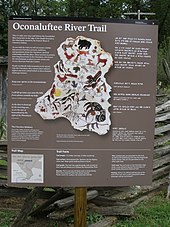Oconaluftee River
|
Oconaluftee River Egwanulti, Ocanaluflee River, Ocona Luftee River, Ocona Lufty River, Oconalufty River, Oconalufey River |
||
|
The Oconaluftee River in the Great Smoky Mountains National Park |
||
| Data | ||
| Water code | US : 1014073 | |
| location | North Carolina (USA) | |
| River system | Mississippi River | |
| Drain over | Tuckasegee River → Tennessee River → Ohio River → Mississippi River → Gulf of Mexico | |
| Confluence of | Beech Flats Prong and Kephart Prong 35 ° 35 ′ 14 " N , 83 ° 21 ′ 42" W |
|
| Source height | 848 m | |
| muzzle |
Tuckasegee River near Bryson City Coordinates: 35 ° 26 ′ 46 " N , 83 ° 23 ′ 2" W 35 ° 26 ′ 46 " N , 83 ° 23 ′ 2" W |
|
| Mouth height | 544 m | |
| Height difference | 304 m | |
| Bottom slope | 10 ‰ | |
| length | 30 km | |
| Discharge at the Birdtown A Eo gauge : 476 km² Location: 5 km above the estuary |
MQ 1946/2019 Mq 1946/2019 |
14.7 m³ / s 30.9 l / (s km²) |
The Oconaluftee River drains the middle and southern Oconaluftee Valley of the Great Smoky Mountains in North Carolina before flowing into the Tuckasegee River . The river flows through the Qualla Boundary , a state land trust that the Eastern Band of Cherokee Indians serve as a nature reserve .
geology
Beech Flats Prong is a creek that is created by the confluence of various springs near Newfound Gap high in the Appalachian Mountains near the North Carolina-Tennessee border. The creek flows about ten miles south where it joins the Smith Branch, Kepharts Prong, and Kanati Fork, creating the Oconaluftee River. It continues to flow south where it joins the Bradley Fork, which significantly increases the amount of water. A larger, flat plain is formed by the confluence of the Raven Fork near Cherokee , at which the river turns west. The river flows through the communities of Smokemount, Oconaluftee Village , Cherokee, Indian Hills and Birdtown before flowing into the Tuckasegee River near Bryson City in Swain County .
history
The Cherokee considered the water of the Ocona Luftee sacred. The name was derived from the name of the Cheroke village Egwanulti , which already existed before the colonization of the region by the Europeans. The name of the village can be translated as by the river . The course of the river and the location of the village existed before the arrival of the early explorer of the region, John Bartram . During the expulsion of the Indians in the 1830s, only the Cherokee who owned or lived on land that belonged to other private individuals were protected from forced relocation. Around 500 Cherokees led by Yonaguska lived on the land of a white man, William Holland Thomas , who bought it as a trustee for the Indians. A smaller clan, led by Utsala, of about 150 people who had lived on the Nantahala River , joined them. Other Cherokee groups lived in Snowbird and on the banks of the Cheoah River, and also stayed in North Carolina. If necessary, they were able to flee to Land Thomas to be protected from displacement. Their descendants now form the Eastern Band of Cherokee Indians . In the 1870s, the Cherokee expanded their land and established the Qualla Boundary.
archeology
Major sites are in the flat areas around the confluences of the Mingus Creek, Toe String Creek, Bradley Fork and Collins Creek.
Web links
Individual evidence
- ↑ USGS 03512000 OCONALUFTEE RIVER AT BIRDTOWN, NC
- ^ Oconaluftee River ( English ) In: Geographic Names Information System . United States Geological Survey . Retrieved July 9, 2020.
- ↑ Florence Cope Bush: Dorie: Woman of the Mountains University of Tennessee Press, 1992, ISBN 978-0870497261 (English)
- ^ William Bright: Native American Placenames of the United States University of Oklahoma Press, 2004, ISBN 978-0-8061-3598-4 (English)
- ↑ James Mooney: Myths of the Cherokee Nineteenth Annual Report of the Bureau of American Ethnology 1897-98, Part I, 1900 ISBN 978-0486289076 (English)
- ^ William Wood, Hiram Wilburn: Southern Indian Studies, vol. 2 - No. 2 1950 in Archeological Society of North Carolina and The Laboratory of Anthropology & Archeology at The University of North Carolina (English)

